
What is the cornea?
The cornea is the clear window at the front of the eye. It is a very delicate structure which is less than a millimetre thick. In order to be transparent, the inner lining of the cornea (endothelium) has thousands of tiny ‘pumps’ that keep water out. It also has no blood vessels. These specialised features make the cornea vulnerable to injury and infection, and results in a slow healing response to deep wounds.
What is senile endothelial degeneration (cornea oedema)?
Senile endothelial degeneration is a corneal condition that occurs in older dogs. The normally clear cornea becomes water-logged and swollen. This is called corneal oedema. It makes the cornea look blue or cloudy, similar to a steamed-up window. The blueness is often mistaken for cataract which is very different – a cataract is when the lens deep inside the eye goes cloudy. Corneal oedema develops if there are not enough pumps, or if the pumps stop working properly. The number of pumps decreases naturally with increasing age in all animals and people. In most dogs, the eyes compensate and no problems occur. Unfortunately, in some dogs, the number of pumps falls to a critical level at which corneal oedema develops.
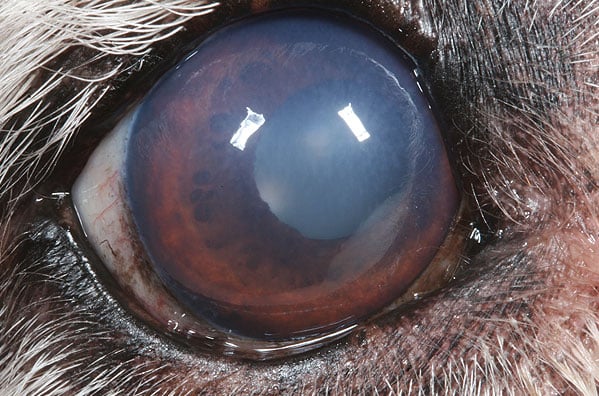
Mild corneal oedema in a Golden Retriever, making the cornea appear ‘steamy’
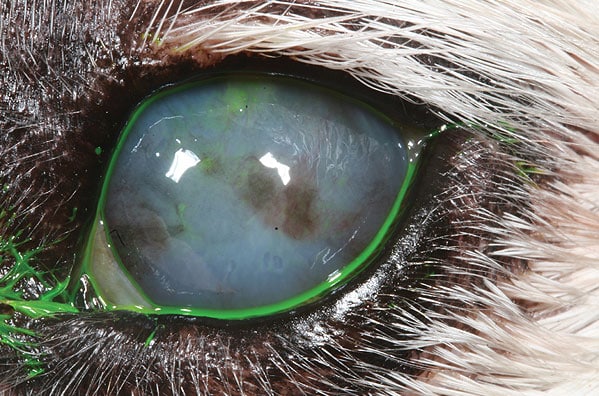
Advanced endothelial degeneration causing marked clouding of the cornea. Ulcers have developed (stained green using a special dye) causing blood vessels and brown pigment to invade the cornea.
Does corneal oedema cause a problem for affected dogs?
Overall, the answer to this question is ‘yes’. In the early stages, corneal oedema causes visual impairment because the clear window at the front of the eye is cloudy or ‘steamed up’. There is no pain at this stage and most dogs cope well. With time, the water-logged cornea becomes over saturated, like a very wet sponge, and small ‘blisters’ form on the surface. These blisters burst spontaneously from time to time and cause small ulcers. The ulcers cause pain which in turn causes symptoms such as blinking, squinting, weeping and light-shyness.
What treatment options are available if my dog has senile endothelial degeneration?
Treatment is usually only indicated if the cloudiness is marked and/or there is pain from ulcers forming in one or both eyes. There are three major treatment options available: Conservative medical treatment with antibiotic and lubricating eye ointments, and painkiller tablets – these medications are designed to reduce irritation and prevent infection until the ulcer heals.
Conservative medical treatment with a special salt eye ointment (sodium chloride ointment) that is applied frequently, e.g. four times daily. This works by drawing water out of the water-logged cornea.
Surgery in the form of a thermokeratoplasty. The aim of a thermokeratoplasty is to stop the ulcers forming, because they are the cause of the pain. The surgery does not reduce the cloudiness of the eye – in some cases it can make it slightly worse (surgery is generally only recommended in advanced cases when the cornea is already very cloudy). The procedure involves the application of multiple, pinpoint burns to the surface of the cornea. The burns stimulate the surface of the eye to form a layer of scar tissue which then reduces the risk of ulcers forming.
In our experience, surgery is the treatment of choice for patients with advanced disease that is causing recurrent ulcers and pain.
What does the surgery (thermokeratoplasty) involve?
A thermokeratoplasty is carried out under general anaesthesia and with the help of the operating microscope. The eyelashes are clipped. During the anaesthetic, the patient’s heart rate, blood pressure and blood oxygen concentration are monitored and a fluid infusion is given intravenously to maintain good blood circulation (see our General Anaesthesia page). A fine needle electrode is applied to the surface of the cornea more than 100 times to create tiny burns. At the end of the procedure, the surgeon will usually place a contact lens on the surface of the eye. The contact lens helps the healing process and makes the eye more comfortable. Following the surgery, the operated eye is usually comfortable, but if the contact lens falls out early on, some dogs will only partially open the eye for a few days.
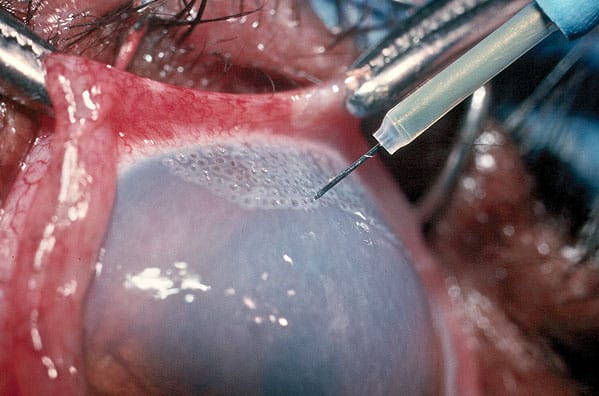
An eye undergoing thermokeratoplasty. The procedure is carried out under general anaesthesia
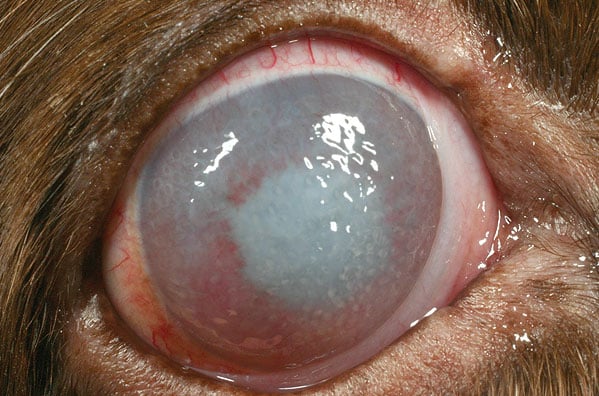
An eye which has had thermokeratoplasty performed ten days earlier. The angry appearance will fade over the next few weeks. The eye is already comfortable
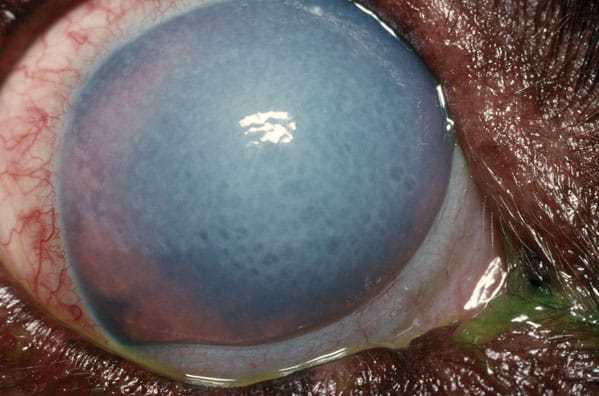
An eye which has healed after thermokeratoplasty
Isn’t my dog too old to have surgery?
Unfortunately, senile endothelial degeneration is a condition of old dogs. Although we prefer to avoid general anaesthesia in elderly animals, it is often the best option we have to relieve the eye pain caused by the disease. The relative risks of your dog undergoing general anaesthesia will be fully considered should this go ahead.
If conservative treatment does not work, the only options remaining are: surgery under general anaesthetic (either thermokeratoplasty or removal of the eye), or, in the absence of surgery, either the presence of ongoing pain or, as a last resort, euthanasia. Of these, thermokeratoplasty is often the best option for giving a good quality of comfortable life, with some hope of retaining a degree of vision in the affected eye(s).
What aftercare will my dog require?
Post-operatively, your dog may need to wear an Elizabethan collar (Buster collar) to prevent damage to the eye(s) by rubbing or scratching. Gentle cleaning of the operated eye with wet cotton wool twice daily is recommended.
An antibiotic drop or ointment is generally applied to the eye for approximately ten days post-operatively. A short course of antibiotic tablets and painkillers may also be given after surgery. The use of false tears or other lubricant preparations may be recommended long-term in some cases, usually to be applied once or twice daily.
How successful is surgery for senile endothelial degeneration?
Thermokeratoplasty is a very successful surgery in uncomplicated cases, and the operation is commonly carried out by our eye team. It is important to realise that success in patients with this condition involves bringing the eye pain to an end, rather than improving vision.
The main risks of the procedure are wound infection and the development of more corneal ulcers. Very rarely, a second procedure may be required to achieve a satisfactory result. Fortunately, the loss of an eye because of complications or progression of the disease after thermokeratoplasty is very rare.
Can my own veterinary surgeon do the thermokeratoplasty?
A thermokeratoplasty is a procedure that requires a skilled and experienced micro-surgeon, equipment for magnification and illumination, and fine surgical instruments that will not damage the delicate tissues of the eye. For this reason most general practitioners will recommend referral to an ophthalmic specialist for treatment of this condition.
Do I have to return to the eye specialist for the aftercare?
After an eye has developed a serious disease which has required an advanced surgical procedure, it is best to have progress checked by the specialist. The number of re-visits will depend upon the severity of the problem and the post-operative progress. In many cases only two or three re-visits will be required. In more complex cases there may be a need to continue with further check-ups from time to time.
Is my dog’s other eye at risk?
Yes. Because this condition is caused by age, both eyes are usually affected. It is common for one eye to have more advanced disease than the other eye. The operation can be performed on both eyes at the same time if necessary.
If you have any queries or concerns, please do not hesitate to contact us.
Arranging a referral for your pet
If you would like to refer your pet to see one of our Specialists please visit our Arranging a Referral page.